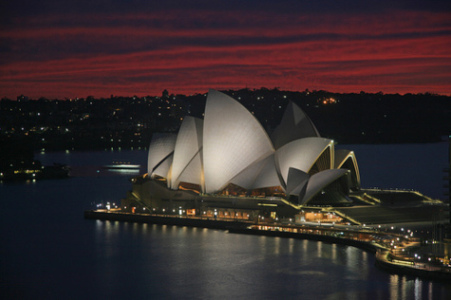Can I sell my photo of the Sydney Opera House? According to the Sydney Opera House, the answer is no. Australian law professor Peter Black recently posted some nice commentary on this issue in his blog, Freedom to Differ. It seems that photographer/blogger Simon Phipps snapped a great shot of Sydney’s landmark and posted it on iStockPhoto. iStockPhoto rejected it on copyright grounds. Then, the Sydney Opera House weighed in, asserting his publication and sale of the photo would violate its trademark rights as well.

The Disputed Photo
Here’s how the Sydney Opera House explained it:
“The SOH brand is a very powerful brand and is well recognised all around the world. This means that the brand is one of the most important assets of the Sydney Opera House Trust. The Sydney Opera House Trust manages the use of Sydney Opera House’s image and brand on behalf of the New South Wales Government. The Trust vigorously protects the commercial exploitation of its intellectual property and does not approve use of the SOH brand in commercial contexts where there is no association between the relevant business and SOH.
“The Trust does this for two reasons - first - to protect the integrity of the brand and second, to protect its commercial value. As a non-profit arts organisation, the Trust is heavily reliant on sponsorships to support its operations and it offers brand association to sponsors of a certain value. In all cases however a sponsor is only permitted to link its product with the SOH brand in a manner that is approved by SOH and which aligns with SOH brand values.”
I’ve got to say, this is a pretty nice explanation as far as cease-and-desist-type letters go. However, it may be wrong on the law. Prof. Black argues the image not only is not protected under Australian copyright law, but it’s probably not protected under Australian trademark either. He writes: “In my opinion, this is a very tenuous assertion and the SOH would struggle to establish that a third party taking a photograph and then selling that photograph would give rise to such an association as I don’t believe that it would be a commonly held assumption that you would need the permission of the SOH to take a photograph of the SOH.”
I’ll happily defer to Prof. Black on Australian law. However, he’d probably be right under United States trademark law. The leading case here is Rock and Roll Hall of Fame and Museum, Inc. v. Gentile Productions, 134 F.3d 749 (6th Cir. 1998), in which the Sixth Circuit doubted that a photograph of Cleveland’s iconic museum could even serve as a a trademark in the first place. It concluded:
“[W]e believe that the district court abused its discretion by treating the ‘Museum’s building design’ as a single entity, and by concomitantly failing to consider whether and to what extent the Museum’s use of its building design served the source-identifying function that is the essence of a trademark. As we have noted, we find no support for the factual finding that the public recognizes the Museum’s building design, in any form, let alone in all forms, as a trademark. In light of the Museum’s irregular use of its building design, then, we believe that it is quite unlikely, on the record before us, that the Museum will prevail on its claims that Gentile’s photograph of the Museum is an infringing trademark use of the Museum’s building design.”